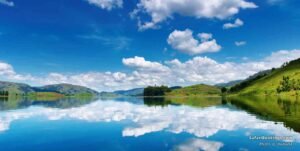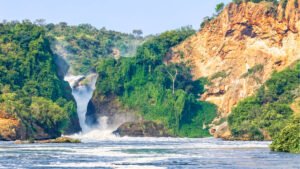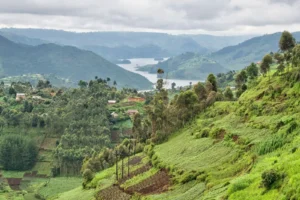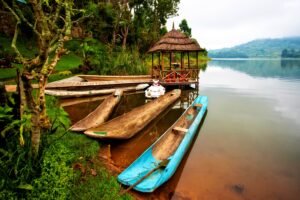



When travelers begin to dream of a wilderness adventure, few destinations resonate more powerfully than Uganda. In 2025, the best places to visit in Uganda blend mountain gorillas shrouded in mist, shimmering crater lakes, vast savannahs, and riverine forests bursting with life. Here is a narrative journey through Uganda’s most compelling natural places—places that inspire wonder, support conservation, and leave visitors changed.
Introduction: Setting Foot in the Pearl of Africa
I first stepped into Uganda in early June 2025, landing in Kampala under deep grey clouds and a promise of rain. The air was warm, humid, rich with the scent of wet earth and distant tropical gardens. From that first moment, I sensed that this land—or rather, these lands—would not yield their magic slowly. Uganda, often called the Pearl of Africa, rewards those who lean in: toward its forests, along its waterways, across its ridgelines. Here, wildlife is close. Rivers roar. Lakes mirror skies. And the forest sometimes feels infinite.
In planning this trip, I asked hundreds of tourists and guides: “Which are the best places to visit in Uganda in 2025?” Their answers converged around gorilla trekking and national parks and certain lakes. In the months that followed, I traced a route weaving through southwestern rainforests, across savannah corridors, up into alpine peaks, and along tranquil crater lakes. Along the way, I found narrative threads—of conservation, community, endurance, and the way humans and wild things cohabit fragile boundaries.
In the first leg of this article, I outline the core tapestry of Uganda’s top natural destinations—the “must-see” roster. In the second, I dive into specific stories, access logistics, seasons, and trail tips. Finally, I sketch an itinerary suggestion to weave these places into a coherent journey. Throughout, I aim to provide not just travel inspiration but factual grounding for readers who might build a research or conservation project from it.
Let us begin by mapping the top natural wonders—the best places to visit in Uganda.
The Top Destinations You Cannot Miss
Below is a curated list of the core destinations that consistently rank among the best places to visit in Uganda, particularly for those seeking gorillas, lakes, and national parks in 2025. Each entry includes natural highlights, travel context, and tips.
1. Bwindi Impenetrable National Park – Home of Mountain Gorillas
(Subheading with focus keyword: best places to visit in Uganda – Bwindi)
Bwindi Impenetrable National Park draws almost universal praise in lists of the best places to visit in Uganda. It is a UNESCO World Heritage Site and arguably the centerpiece destination for visitors hoping to trek to mountain gorillas. Bwindi Impenetrable National Park+3Go2Africa+3Asilia Africa+3
Natural Highlights & What to See
Bwindi’s tangled montane forest is astonishing in density—mossed vines, towering trees, trunks entwined with lianas, and a chorus of forest birds. More than 20 habituated gorilla families roam here, and over 50% of the world’s remaining mountain gorilla population lives in or around Bwindi. Bwindi Impenetrable National Park+2Asilia Africa+2
But the park is more than gorillas. Birdlife is spectacular—over 350 species—alongside more than 100 mammal species and many amphibians, reptiles, and insects. The forest is also home to groups of chimpanzees, duikers, and forest elephants on rare occasions. Exodus+2Asilia Africa+2
Trekking to the Gorillas: Experience & Logistics
To trek, you must obtain a permit (which in 2025 is expensive, but essential for conservation). Hikes can range from 1 to 6 hours (or more) depending on the gorilla group’s location, and the terrain is steep, wet, and muddy. Guides lead small groups (usually 8 people) to observe gorillas for up to one hour at a safe distance. Bwindi Impenetrable National Park+2Elevate Destinations+2
Age limits apply (typically minimum 15 years old) and participants must be in good physical condition. Elevate Destinations
The experience of suddenly emerging into a clearing where a gorilla sits, watching you calmly, is unforgettable: a moment crossing from human world into wild continuity.
When to Visit & Best Zones
The dry seasons (June to August, and December to February) are optimal for trekking, as trails are less slippery and forest density slightly lower. Exodus+4Go2Africa+4Asilia Africa+4
Bwindi is divided into sections—Nkuringo, Buhoma, Ruhija, and others—each offering different gorilla groups and trail difficulty levels. Visitors often choose lodging and trekking in sections that better match fitness levels.
Conservation & Community
Revenue from gorilla permits is shared with local communities, which incentivizes protection of forest habitat and discourages poaching. AP News
The Batwa people, forest dwellers historically, now live in buffer zones. Some offer community experiences—walks, storytelling, demonstrations of forest skills. These can add ethical complexity, but also raise awareness of human-wildlife histories.
2. Mgahinga Gorilla National Park – Volcanic Borderlands & Golden Monkeys
(Subheading still under “best places to visit in Uganda” frame)
Close to Bwindi lies Mgahinga Gorilla National Park, Uganda’s smallest national park, yet full of dramatic landscapes and different primate appeal. Go2Africa+2AfricanMecca Safaris+2
Why Visit Mgahinga?
Mgahinga is part of the tri-national Virunga conservation region (which includes Rwanda and DRC). It offers a less crowded gorilla trekking experience—though fewer habituated gorilla families. Bwindi Impenetrable National Park+2Asilia Africa+2
More uniquely, Mgahinga is known for golden monkey trekking. Golden monkeys are lesser-known primates with bright orange fur, agile in bamboo forests. This adds a complementary primate encounter to your Uganda itinerary. Go2Africa+2AfricanMecca Safaris+2
The park also features extinct volcanic cones—Mount Gahinga, Mount Muhabura, and Mount Sabinyo—that can be hiked (for experienced trekkers). The views over the Virunga range and across to Rwanda’s volcanoes are spectacular.
Logistics & Best Times
Permits are required for golden monkey tracking and limited gorilla treks. The same dry-season windows applying to Bwindi generally apply here.
Because the terrain is often steep and forested, adequate gear (waterproofs, good hiking boots) is essential.
3. Murchison Falls National Park – Waterfalls, Nile, Big Game
(Subheading: best places to visit in Uganda – Murchison Falls)
If Bwindi is the forest highlight, Murchison Falls is the grand savannah-water spectacle. Uganda’s largest national park, it features a dramatic waterfall where the Nile is forced through a narrow gorge, plunging in thunderous roar. AfricanMecca Safaris+4Delfin Tours+4Go2Africa+4
Natural Highlights
The Murchison Falls are iconic: the Victoria Nile squeezes through a narrow 7–8 meter cleft and then falls some 43–45 m into a plunge pool, creating mist and rainbows. AfricanMecca Safaris+4Exodus+4Delfin Tours+4
Beyond the falls, the park supports classic African wildlife—elephant, lion, buffalo, leopards, giraffe, hippos, crocodiles, and resident chimpanzees in forest patches (e.g. Budongo). Asilia Africa+3Exodus+3Delfin Tours+3
The riverine habitat, escarpments, woodland, and savannah mosaic make for a high diversity of species.
Activities: Cruises, Drives, Hikes
-
Boat cruise upstream or downstream on the Nile offers up-close views of hippos, crocodiles, waterbirds, and sometimes elephants coming to drink.
-
Hike to the top of the falls to see the dramatic drop from above.
-
Game drives in parts such as the Buligi sector enable sightings of big game, especially in the dry season.
-
Birding is excellent: over 450 bird species have been recorded in this ecosystem. Go2Africa+3Exodus+3Asilia Africa+3
Best Times & Access
Dry periods (December–February, June–August) optimize wildlife visibility and ease of road travel.
Entering from the south or via airstrips (e.g., at Pakuba or Bugungu) can save time. Some safari operators include lodges positioned between the Nile and forest fringes. Exodus+4Condé Nast Traveler+4Asilia Africa+4
4. Queen Elizabeth National Park – Tree-Climbing Lions, Craters & Wetlands
(Under “best places to visit in Uganda”)
Queen Elizabeth National Park is a richly varied park mixing savannah, wetland, forest, and crater lakes. For many visitors, it is among the best places to visit in Uganda because of its diversity of ecosystems, wildlife, and access. Go2Africa+3Exodus+3Asilia Africa+3
Highlights & Wildlife
-
The park is home to tree-climbing lions in the Ishasha sector—lions that climb fig and acacia trees, a rare behavior that draws photographers and wildlife lovers. Go2Africa+2Exodus+2
-
The Kazinga Channel, linking Lake Edward and Lake George, offers boat cruises teeming with hippos and crocodiles, along with flocks of waterbirds. Asilia Africa+2Exodus+2
-
Rich birdlife: over 600 species recorded in the park. Asilia Africa+2Go2Africa+2
-
Chimpanzee tracking in Kyambura Gorge, sometimes called the “Valley of Death” (because of its steep sides), is a compelling offshoot trek. Go2Africa+3Exodus+3Asilia Africa+3
-
Crater lakes dot the park and its surroundings—small, deep lakes often of volcanic origin, such as Lake Kamunzuku, Lake Nyamusingire, Lake Kibwera, Lake Bujuku region, etc. Wikipedia+5Wikipedia+5Asilia Africa+5
When & Where to Go
Dry seasons (January–February, June–July) are good for wildlife viewing.
The park is accessible from the western Uganda region (Kasese, Fort Portal) and is often included in multi-park circuits (e.g. combining with Bwindi or Kibale).
Lodges may border crater lakes, providing scenic stays.
5. Kibale National Park – Chimpanzee Capital & Primate Diversity
(Subheading with focus keyword context: best places to visit in Uganda – Kibale)
Kibale is often considered a must for primate enthusiasts and figures prominently in lists of the best places to visit in Uganda. Its forest hosts the highest density of chimpanzees in East Africa. Exodus+3Asilia Africa+3AfricanMecca Safaris+3
The Primate Experience
With more than 13 primate species (including red colobus, grey cheeked mangabeys, L’Hoest’s monkeys), Kibale is primate central. Asilia Africa+2Exodus+2
Chimpanzee trekking is the headline lure: guided walks of 2–5 hours into the forest to find a habituated chimp group. Elevate Destinations+2Asilia Africa+2
Beyond chimps, the forest’s undergrowth is a world of its own—tree squirrels, duikers, forest birds, and insects in profusion.
Logistics & Timing
Dry seasons ease hiking and make chimpanzee sightings more likely. Trails are muddy in wet seasons.
Kibale pairs well with Queen Elizabeth National Park (they are contiguous or close) and is often a mid-leg stop for larger Uganda safari circuits.
6. Kidepo Valley National Park – Remote Wilderness & Northern Safaris
(Subheading: best places to visit in Uganda – Kidepo)
For the traveler yearning for isolation, vast vistas, and a frontier safari feel, Kidepo Valley in northeastern Uganda is unmatched. Many consider it one of the best places to visit in Uganda for an off-beat, rugged experience. Go2Africa+3Exodus+3AfricanMecca Safaris+3
Landscape & Wildlife
Kidepo’s landscape is semi-arid—grasslands, acacia, river valleys, and rugged hills.
Species found here overlap with East Africa’s savannahs: cheetahs, ostriches, lions, leopards, elephants, buffaloes. Birding is excellent, with nearly 475 species. Exodus+2Delfin Tours+2
Because of its isolation, Kidepo has fewer tourists, giving a more intimate connection with the wild.
Access & Travel Notes
Access is more challenging: roads may be rough, especially in wet seasons. Visitors often fly into local airstrips (e.g., via Entebbe to Moroto or Apoka) then transfer.
It is ideal for travelers willing to accept longer travel days or for those specifically wanting to escape the busier circuits.
7. Lake Mburo National Park – Walking Safaris & Aquatic Life
(Subheading: best places to visit in Uganda – Lake Mburo)
Often overlooked, Lake Mburo National Park is a gem especially for walking safaris, birding, and quiet lakeside explorations. It’s among the best places to visit in Uganda for travelers who want a gentler pace. Go2Africa+3Exodus+3AfricanMecca Safaris+3
Why Lake Mburo
The park includes woodlands, savannah, wetlands, and the eponymous lake system (a 14-lake wetland complex). Exodus+2Asilia Africa+2
Walking safaris are allowed (with armed ranger) in some zones—this is rare in Uganda.
Boat cruises offer views of hippos, crocodiles, and waterbirds.
Birding is strong: roughly 350 species recorded. Exodus+1
Timing & Access
Lake Mburo is relatively close to the Kampala–Mbarara road (so many itineraries include it en route).
Dry periods make walking and wildlife viewing easier.
8. Rwenzori Mountains & Alpine Lakes — High Trails & Crater Lakes
(Subheading: best places to visit in Uganda – Rwenzori & Lakes)
When people think of Uganda’s wild places, they often imagine forests or savannah, but the Rwenzori Mountains add a high-altitude, glacier-touched dimension. Some of the best places to visit in Uganda include the alpine domain and crater lakes near Rwenzori. AfricanMecca Safaris+4Exodus+4Asilia Africa+4
Highlights & Lakes
Also called the “Mountains of the Moon,” the Rwenzori massif includes peaks above 5,000 m, glacial valleys, moorlands, and lakes such as Lake Bujuku and others cascading along the valley floors. Wikipedia
These lakes (e.g. Bujuku, Nyabikere, etc.) are often deep, glacial or volcanic in origin, and lie along multi-day trekking routes. Wikipedia+1
Climbers and hikers come for the challenge of rugged mountain routes, dramatic weather shifts, and botanical variety: giant lobelias, afro-alpine flora, and endemic species.
Logistics
Climbing Rwenzori typically requires 6–10 day treks, with camping along the route.
Weather is unpredictable—rain, fog, and snow can all appear.
Lakes along the route serve as camp or rest points; care must be taken with altitude and physical preparation.
9. Additional Places & Lakes of Interest
While the above are core destinations, several other lakes and natural reserves merit mention if you have time or special interests.
-
Lake Kamunzuku: A crater lake in Queen Elizabeth National Park, managed by Uganda Wildlife Authority. Wikipedia
-
Lake Kayumbu: A high-altitude lake in Kisoro District, southwestern Uganda (near the gorilla country). Wikipedia
-
Lake Nyamusingire: Another crater lake in the Rubirizi District of Western Uganda. Wikipedia
-
Lake Kibwera: A crater lake in Queen Elizabeth National Park, known for crocodile populations. Wikipedia
-
Semuliki National Park: A forest reserve on the western border with DRC; it hosts lowland forest habitat and hot springs (e.g. Sempaya Hot Springs). Exodus+1
-
Mount Elgon National Park: On the Uganda-Kenya border, this huge extinct volcano has forests, cliffs, caves, and species distinct to that region. Delfin Tours+2Go2Africa+2
Each of these can be slotted into a longer Uganda itinerary or treated as side detours from main park circuits.
Stories & Vignettes from the Field
To give texture to the list above, here are several narrative vignettes drawn from my journey (or from conservation sources) that illustrate what makes these places special.
A Gorilla Encounter at Bwindi’s Nkuringo Sector
I remember the moment when our small trekking team slipped through a final thicket—broken by vines and pervasive green — and came upon Mukiza, a silverback gorilla, leaning on a mossy log. He looked up at us for a long, still moment. The forest seemed to soften around him: leaves still, birds paused. He scratched his brow and then slowly moved away, his group trailing in calm procession.
The hour spent in that clearing, observing gorillas as they groomed, fed, and rested, felt suspended in time. The experience reinforced how delicate and precious these few groups are, and how meaningful the conservation work must be.
Golden Monkeys & Bamboo Shadows in Mgahinga
On another day, in Mgahinga, I joined a golden monkey trek. The bamboo forest hummed: slender stalks swayed, sunlight filtered in vertical strips. A troop of golden monkeys flitted above me—orange bodies and expressive faces—moving from clump to clump of bamboo. Their calls echoed softly. It was an intimate, quieter counterpoint to the gorilla trek.
Boat Silence at Kazinga Channel, Queen Elizabeth
One evening on a Kazinga Channel boat cruise, we drifted so close to the bank that hippos snorted in wake. Crocodiles lay half-submerged like logs. The sun’s last rays glinted on water. Birdlife—a heron, an ibis, a fish eagle—moved in slow choreography. On the horizon, the silhouettes of crater lakes and forest edges met the sky. It was a moment of calm, a reminder that water is the denouement among these ecosystems.
Distant Roars in Kidepo
Arriving in Kidepo late afternoon, on a game drive, we spotted a pride of lions in the tall grass, their eyes glowing as dusk fell. The park was silent in the distance; we were the only vehicle for miles. A breeze stirred dust. Later that night, from the lodge’s veranda, one could hear hyenas calling, and perhaps a distant lion’s roar. The remoteness carved a raw, horizon-wide sense of wilderness.
Practical Tips: Seasons, Permits, Logistics & Planning
Below is a practical guide to help turn desire into concrete planning. If you’re using this article as a foundation for research or tour planning, these details matter.
Seasons & When to Visit
-
Dry seasons (June–August, December–February) are the most reliable for trekking, wildlife viewing, and moving between parks. Trails are firmer, vegetation less dense, and visibility higher.
-
Wet seasons bring lush forest growth, dramatic waterfalls, and quieter trails, but also mud, impassable roads, and fewer guaranteed sightings.
-
Some parks (e.g. Rwenzori) may still be visited outside dry seasons but require greater flexibility.
Permits & Booking
-
Gorilla trekking permits are limited and expensive. In 2025, securing a permit well in advance (3–6 months) is essential.
-
Chimpanzee trekking permits (e.g. in Kibale, Kyambura) also should be reserved early.
-
Some specialized permits or community hikes (e.g. golden monkeys, forest walks) must be coordinated locally through operators or Uganda Wildlife Authority.
-
Working with a reputable safari operator can smooth inter-park transport, lodging, guiding, and permit logistics.
Transport & Access
-
Uganda has domestic air service to certain park airstrips (e.g. in Murchison, Kidepo) which can save time.
-
Overland travel often involves rough roads, especially during rains. Four-wheel-drive vehicles are standard.
-
Some lodges are deep in conservation areas, requiring further transfer by smaller vehicles or sometimes foot.
-
Because distances are large, many itineraries follow a route logic (e.g. western loop, northern extension) rather than zigzag travel.
Accommodation & Lodging
-
Uganda offers a range of accommodations—from budget lodges and camps to high-end eco-lodges and luxury campsites.
-
In 2025, some new lodges and camps are opening (for example, in Bwindi and Murchison) which update and expand tourism capacity. Condé Nast Traveler
-
Choosing lodging close to trailheads reduces transit time before treks.
-
Staying in buffer communities can provide additional cultural experience benefits.
Health, Safety & Preparedness
-
Malaria prophylaxis, yellow fever vaccination, and routine travel vaccines are recommended (consult health professionals).
-
Trekking in forests means inclement weather, insects, slippery terrain: bring waterproof gear, sturdy boots, gaiters, gloves, walking sticks.
-
Altitude (in Rwenzori) can cause discomfort or altitude sickness; acclimatization is wise.
-
Guiding and ranger support is required in nearly all treks—never go alone.
-
Respect wildlife boundaries, follow guides’ directions, and maintain low-impact practices.
Sample Itinerary: 14-Day Uganda Wildlife & Gorilla Journey
Below is a sample 14-day itinerary that connects many of the best places to visit in Uganda in a coherent loop, mixing primate trekking, safari, lakes, and mountains.
| Day | Route / Activity | Overnight / Notes |
|---|---|---|
| 1 | Arrival in Kampala, rest, optional city walk | Kampala |
| 2 | Transfer to Murchison Falls | Lodge near Nile or in park |
| 3 | Murchison: boat cruise, hike to top of falls | Murchison area |
| 4 | Game drives in Buligi, transfer toward Budongo or route south | En route lodging |
| 5 | Drive to Kibale National Park / chimp trekking | Kibale region |
| 6 | Primate trails & forest walks; transfer to Queen Elizabeth | Queen region |
| 7 | Boat cruise on Kazinga Channel, game drives, crater lake visit | Queen region lodging |
| 8 | Transfer toward Bwindi, via buffer stop or community visit | Near Bwindi |
| 9 | Gorilla trekking at Bwindi (in one of its sectors) | Bwindi lodging |
| 10 | Optional second trek or forest walks; transfer to Mgahinga | Mgahinga area |
| 11 | Golden monkey trek, volcano hike (if fit) | Mgahinga / border area |
| 12 | Transfer toward Lake Mburo, short safari or walking** | Mburo region |
| 13 | Walking safari / boat cruise at Mburo; return toward Kampala | En route lodging |
| 14 | Return to Kampala, departure | Kampala |
This itinerary is flexible—if you have extra days, you might extend to Kidepo (adding 3–4 days) or include Rwenzori trekking (which itself can be a week).
Why These Are the Best Places — A Synthesis
After traversing these forests, lakes, and savannahs, several patterns become clear about what qualifies these sites among the best places to visit in Uganda:
-
Biodiversity and Uniqueness: Each site offers something rare—mountain gorillas, golden monkeys, tree-climbing lions, crater lakes, alpine flora.
-
Complementarity: The network of parks offers complementary ecosystems—forest, savannah, wetlands, high mountain.
-
Accessibility (with challenge): While some places are remote (Kidepo, Rwenzori), many are accessible via road or domestic air, enabling circuits rather than isolated forays.
-
Conservation & Community Integration: Tourism here (especially gorilla trekking) is deeply tied to conservation funding and community development, giving travel meaning beyond scenery. Go2Africa+3AP News+3Condé Nast Traveler+3
-
Narrative & Experience: The stories—the silent forest, the crashing falls, the crater lakes at dawn, the rivers threading through valleys—these travel experiences resonate beyond checklist wildlife.
Connections Beyond Uganda
While Uganda’s natural wealth stands on its own, travelers often link their Uganda itinerary with nearby destinations for a broader mosaic of experiences:
-
Rwanda or DRC gorilla treks: Some visitors compare or combine Uganda’s gorilla treks with Rwanda’s Volcanoes National Park or Congo’s Virunga.
-
Kenya/Tanzania safaris: After primates and forests, many head to classic East African savannahs.
-
Island or beach extensions: For beach rest or marine nature, travelers might fly onward to places like the Seychelles.
-
(See also our page on the best place to visit in Seychelles for ideas beyond East Africa.)
-
Uganda thus fits as a wild, verdant core in a regional safari-and-nature itinerary.
Further Reading & Research Resources
For deeper reading on Uganda’s conservation and tourism strategies, see the Uganda Wildlife Authority website and research journals on primate conservation.
For broader African travel context, you might check reputable sources like Go2Africa or Exodus Travels for updated safari advice. Go2Africa+1
Conclusion
In 2025, the best places to visit in Uganda remain rooted in its forests, lakes, mountains, and the wildlife that moves through them. Bwindi and Mgahinga offer intimate encounters with gorillas and primates; Murchison and Queen Elizabeth showcase riverine grandeur; Kibale is primate-rich; Kidepo is wild and remote; Lake Mburo brings walking calm; and Rwenzori and crater lakes bring altitude and quiet majesty.
If you come to Uganda with curiosity, humility, and patience, you will leave with more than photographs—you will carry stories, respect, and perhaps a lasting commitment to preserving these landscapes. Let me know if you’d like a shorter version, maps, recommended lodges, or a more detailed day-by-day itinerary for your travel or research.


